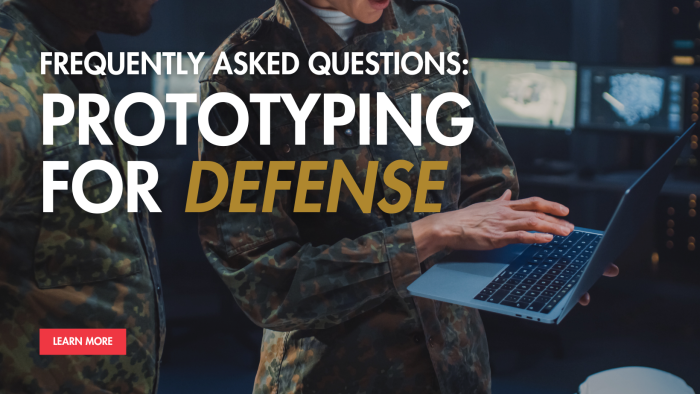Frequently Asked Questions About Prototyping for Defense

In this blog, we dive deep into the essentials of prototyping, offering insights into everything from the scale and simplicity of prototypes to their indispensable role within the Department of Defense (DoD). This comprehensive guide illuminates the path from conceptualization to realization.
Can a Prototype Be Small?
Absolutely. A prototype does not need to be large or elaborate to be effective. The primary purpose of a prototype is to test and explore concepts, functionalities, or designs in a tangible way.
Small prototypes can be incredibly valuable, especially in the early stages of development when the focus is on validating the core idea or feature set. These scaled-down versions allow for quick iterations and can help identify potential issues or improvements without the need for substantial resources.
What is a Simple Prototype?
A simple prototype is a basic version of a product that is created to test a concept or design. It focuses on the most essential features, disregarding the complexities of a fully developed product.
Simple prototypes are often used to assess the viability of an idea, communicate a concept to stakeholders, or refine the user experience. They can take various forms, such as sketches, 3D printed models, or basic software applications, depending on the nature of the product being developed. Our team of engineering experts is able to create whatever our customers need, whether that be a drawing, a CAD, or somewhere in between.
What is the DoD Definition of Prototype?
A prototype is a preliminary model of something from which other forms are developed or copied. Prototyping is crucial for validating technologies, systems, and components under development in defense and military applications.
The DoD emphasizes using prototypes for experimentation, testing, and evaluating new concepts and capabilities before fully integrating them into operational use. This approach helps mitigate risks and ensure that new technologies meet the rigorous standards and requirements of military applications.
What are Examples of Prototypes?
Prototypes can range from basic models made of cardboard and tape to advanced pre-production versions that closely resemble the final product.
Examples include:
- Software Prototypes: Early versions of a software application designed to demonstrate functionality or a user interface design.
- Product Design Models: Physical models created to explore a product’s form, ergonomics, or aesthetics.
- Engineering Prototypes: Functional units used to test a new device or component’s mechanical, electrical, or thermal properties.
- Architectural Models: Scale models of buildings or structures used for design validation and stakeholder presentation.
What is the Minimum Prototype?
The minimum prototype, or minimal viable prototype (MVP), is the simplest form of a prototype that still allows for the key functions or features to be tested and evaluated. It focuses on the product’s core value proposition, excluding any non-essential features or functionalities.
The MVP approach is particularly popular in software development and startups, whose goal is to quickly validate a product concept with the least development effort and cost.
Does a Prototype Have to be Full-Size?
No, a prototype does not have to be full-size. The scale of a prototype can vary widely based on the objectives of the prototyping exercise and the practicalities of manufacturing and testing.
Smaller scale models can be used to evaluate specific design aspects, such as ergonomics or spatial relationships, while larger, more detailed prototypes might be necessary to test functionalities and user interactions comprehensively.
From Idea to Done: Your Project with JAKTOOL
At JAKTOOL, our passion is your passion. We’ve helped hundreds of customers over our more than two decades in business bring their products to life through prototyping. We have experience taking a wide variety of products from the idea phase to done. Our team of experienced engineers is ready to discuss how we can bring your idea to life. Reach out today.
What is The Vision Vault?
The JAKTOOL Vision Vault is a space for us to expand on the passions that drive innovation and growth at our company. On this blog, we’ll take deeper dives into industry news and our expertise and highlight the leaders we have under our own roof through featured blogs. Follow along for updates throughout the month and recaps on new episodes of JAKTALK, our biweekly podcast hosted by our founder, COO, chairman, and visionary, Jeff Kinsberg.
